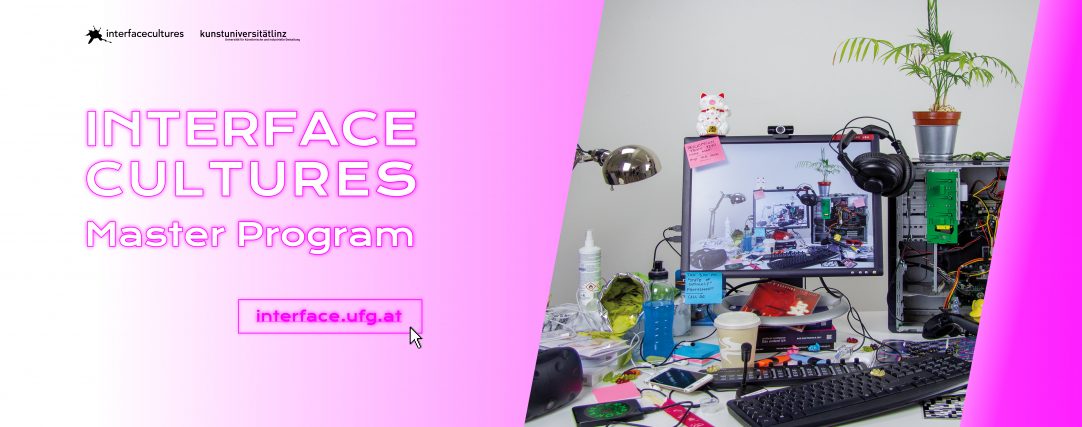“Post-Post” Exhibited Projects
Opening time:
3rd – 7th September
Open daily from 10:00 to 19:00
The location of this year’s student exhibition in Interface Cultures is interesting in many ways: it is the former headquarters of the Austrian Post Office in Linz. Last year this company moved out and this year the Interface Cultures students have moved in. There, 23 international students will exhibit art works which they realized during the past year of studies.
Visitors can expect a variety of projects, which will be just as multifaceted as the lectures at the department of Interface Cultures. Some examples are briefly described in the following paragraphs.
Inspired by the Games Workshop, Nathan Guo developed his project “Wanderlust”, which utilizes the digital dartboard system as an agent of a Google map navigator. Patricia Margarit Castelló produced a collective videogame called „Eisenbahnbrücke’s nightmare“ (The Nightmare of the Railroad Bridge), that has to do with urban development and shows us how historical buildings are currently being dealt with.
The lecture in media archeology probably had an influence on the installation “OHP III”, which was created by Davide Bevilacqua and Clemens Bauder. They use overhead projectors with additional film rolls in a manner that turns them into alternative cinematic devices. By hacking objects Yen Tzu Chang develops her series of works called „Transplanting“. She originates from Taiwan and has noticed that many everyday objects are used more or less frequently in Austria than in her home country. This observation inspired her to develop electronic products and combine them with parts of the human body. In Jure Fingust´s project „Take your time“ a common traffic light is used in a totally different context than the usual one.
Daniel Samperio and Gisela Nunes are two exchange students from the University of Minho in Guimarães, Portugal. They made use of their residence at Interface Cultures to improve their current projects. Gisela Nunes´ installation „Break the Ice“ invites the visitors to participate. It asks them to step on a sheet of ice and see what happens! Daniel Samperio developed the artwork „Medium Standard“ together with Mario Costa In the collaborative space it defines, three tangible objects – coins, dry leaves and a Newton´s cradle- control the multi-media environment in real-time.
The critical use of technological developments is the basis of “LARD” by Oliver Lehner. He employs long range acoustic devices (LARDs), which are normally used by the military and the police to control agitated crowds, as an organ of speech for the voices of protest from all over the world. Nina Mengin´s critical statement on the usage of social platforms is called „#innerstagram“. She questions the widespread belief that every single moment of our life is worthy of being captured with a mobile phone. Pictures of a different kind represent the point of departure for Isidora Ficovic´s exhibit, which is called “The gesture of drawing light with a body movement, Form 24”. There, a digital camera becomes the object, which displays abstract graphics that are digitally produced in the course of an interactive performance.
Movement or not? That is the question posed by three art projects that are presented in the exhibition. Martin Nadal´s „Death of Things (DoT)“ is a series of moving figures representing public personas. What they do depends on whether the people they represent are still alive. While the pictures in Ivan Petkov´s installation „Time Based Ghosts“ are switched off, you won´t see any content. Shapes seem to emerge from irregularly blinking points until the video is stopped. The installation „Pop the Movies“ by Carina Lindmeier and Federico Tasso is based on a popcorn machine which activates the movies. Every time a piece of popcorn pops, the movie moves forward by one frame.
What if, in real life, we were able to make a connection with a conversational topic instead of a person? „BullShut App“ is a mobile phone application which attempts to make it possible to avoid awkward moments at all kinds of social events. The goal of the project which Marta P. Campos and Tassilo Posegga present is to create a conversational space that connects two individuals for a brief period of time. An interaction of a total different kind is the basis of „Interfight” by César Escudero Andaluz. He uses an Android app, which he developed by duplicating the android GUI. In it, desktop icons are made to behave like animals and react aggressively to the physical interface.
Another project of a more applied nature was developed by a group of students of Industrial Design and Interface Cultures. In it, they elaborate future scenarios for car break downs in 2050. In their collaboration with the Austrian ÖAMTC, they discuss service issues such as “what will mobility be like in 2050”.
Jens Vetter developed the “Netz”, a net of flexible rubber tubes which is suspended in a room. In the middle of it, there is a speaker. Touching or stretching the net generates a sound that it will play back.
As we see, this year’s student projects really do move freely between the different media: digital, analog retro, new and old. They are composed of media, post media and post-post media.
















